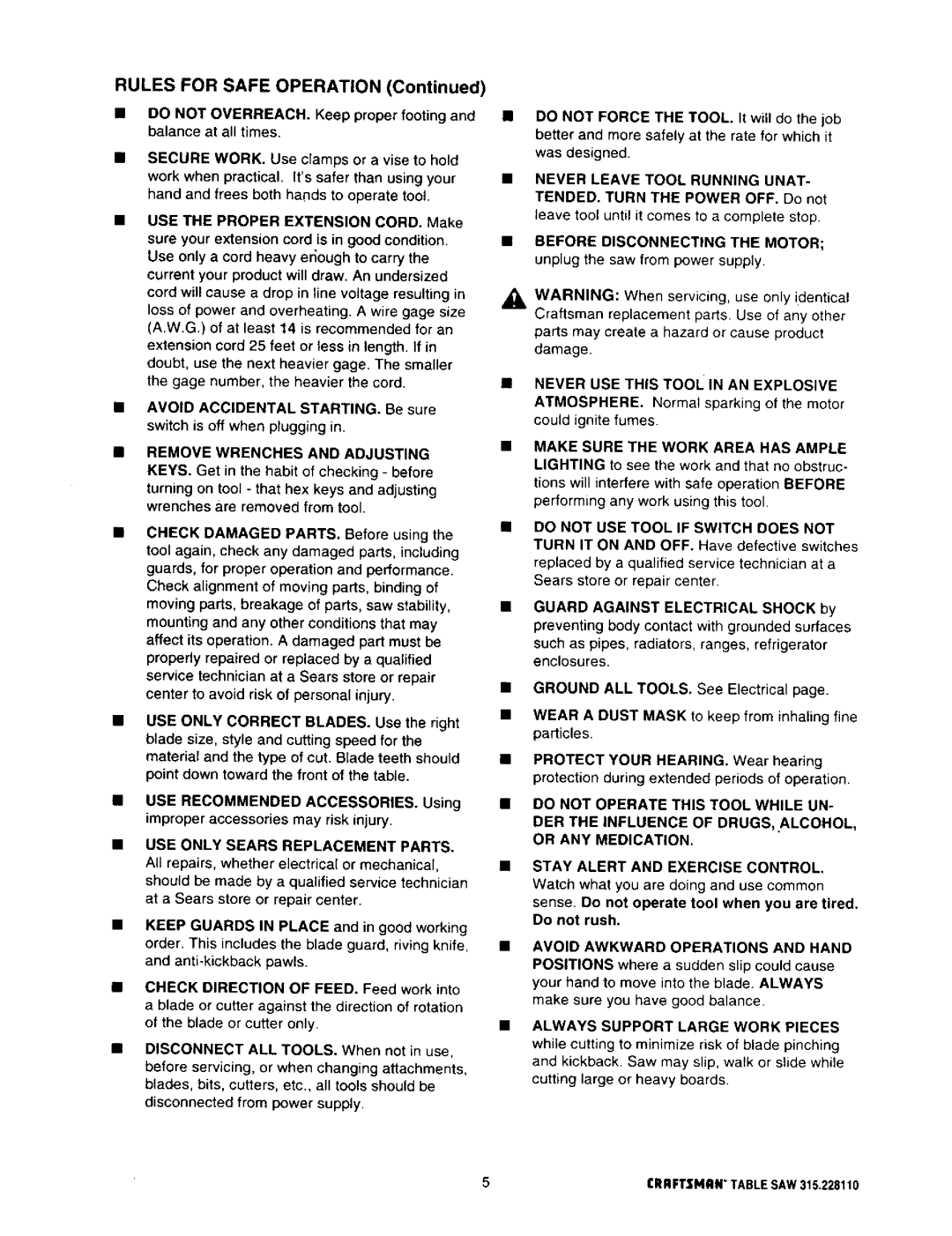
RULES FOR SAFE OPERATION (Continued)
•DO NOT OVERREACH. Keep proper footing and balance at all times.
SECURE WORK. Use clamps or a vise to hold work when practical. It'ssafer than using your hand and frees both hands to operate tool.
USE THE PROPER EXTENSION CORD. Make sure your extension cord is in good condition.
Use only a cord heavy er_oughto carry the current your productwill draw. An undersized
cord will cause a drop in line voltage resulting in loss of power and overheating. A wire gage size (A.W.G.) of at least 14 is recommended for an
extension cord 25 feet or less in length. If in doubt, use the next heavier gage. The smaller the gage number, the heavier the cord.
AVOID ACCIDENTAL STARTING. Be sure switch is off when plugging in.
REMOVE WRENCHES AND ADJUSTING KEYS. Get in the habit of checking - before
turning on tool - that hex keys and adjusting wrenches are removed from tool.
CHECK DAMAGED PARTS. Before using the tool again, check any damaged parts, including guards, for proper operation and performance. Check alignment of moving parts, binding of moving parts, breakage of parts, saw stability, mounting and any other conditionsthat may affect its operation. A damaged part must be properly repaired or replaced by a qualified service technician at a Sears store or repair center to avoid risk of personal injury.
USE ONLY CORRECT BLADES. Use the right blade size, style and cutting speed for the material and the type of cut. Blade teeth should point down toward the front of the table.
USE RECOMMENDED ACCESSORIES. Using improper accessories may risk injury.
USE ONLY SEARS REPLACEMENT PARTS. All repairs, whether electrical or mechanical, should be made by a qualified service technician at a Sears store or repair center.
KEEP GUARDS IN PLACE and in good working order. This includes the blade guard, riving knife, and
CHECK DIRECTION OF FEED. Feed work into a blade or cutter against the direction of rotation of the blade or cutter only.
DISCONNECT ALL TOOLS. When not in use, before servicing, or when changing attachments, blades, bits, cutters, etc., all tools should be disconnected from power supply.
•DO NOT FORCE THE TOOL. It will do the job better and more safely at the rate for which it was designed.
•NEVER LEAVE TOOL RUNNING UNAT- TENDED. TURN THE POWER OFF. Do not leave tool until it comes to a complete stop.
•BEFORE DISCONNECTING THE MOTOR; unplug the saw from power supply.
WARNING: When servicing, use only identical Craftsman replacement parts. Use of any other parts may create a hazard or cause product damage.
NEVER USE THIS TOOL IN AN EXPLOSIVE
ATMOSPHERE. Normal sparking of the motor could ignite fumes.
MAKE SURE THE WORK AREA HAS AMPLE LIGHTING to see the work and that no obstruc- tions will interfere with safe operation BEFORE performing any work using this tool.
DO NOT USE TOOL IF SWITCH DOES NOT TURN IT ON AND OFF. Have defective switches replaced by a qualified service technician at a Sears store or repair center
GUARD AGAINST ELECTRICAL SHOCK by preventing body contact with grounded surfaces
such as pipes, radiators, ranges, refrigerator enclosures.
•GROUND ALL TOOLS. See Electrical page.
•WEAR A DUST MASK to keep from inhaling fine particles.
•PROTECT YOUR HEARING. Wear hearing protection during extended periods of operation.
•DO NOT OPERATE THIS TOOL WHILE UN-
DER THE INFLUENCE OF DRUGS, ALCOHOL, OR ANY MEDICATION.
STAY ALERT AND EXERCISE CONTROL. Watch what you are doing and use common
sense. Do not operate tool when you are tired.
Do not rush.
•AVOID AWKWARD OPERATIONS AND HAND POSITIONS where a sudden slip could cause your hand to move into the blade. ALWAYS make sure you have good balance.
•ALWAYS SUPPORT LARGE WORK PIECES while cutting to minimize risk of blade pinching and kickback. Saw may slip, walk or slide while cutting large or heavy boards,
5 | CRRFTSMaW TABLESAW315.228110 |
